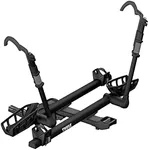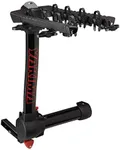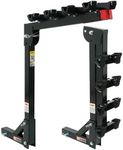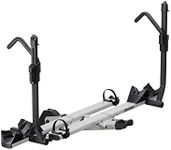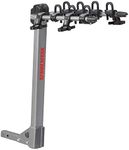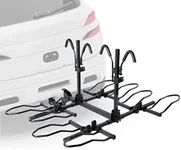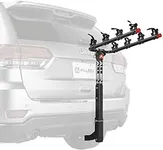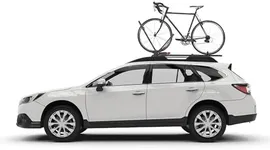Buying Guide for the Best 4 Bike Hitch Racks
Choosing the right 4-bike hitch rack can make transporting your bikes easier and more secure. When selecting a hitch rack, it's important to consider several key specifications to ensure it meets your needs and fits your vehicle properly. Here are the key specs to look at and how to navigate them.Hitch Receiver SizeThe hitch receiver size is the part of the rack that attaches to your vehicle's hitch. It is important because it determines compatibility with your vehicle. Hitch receivers typically come in two sizes: 1.25 inches and 2 inches. Most larger vehicles like SUVs and trucks have a 2-inch receiver, while smaller cars may have a 1.25-inch receiver. Check your vehicle's hitch size and ensure the rack you choose matches it.
Weight CapacityWeight capacity refers to the maximum weight the rack can safely carry. This is crucial to ensure the rack can handle the combined weight of all your bikes. Weight capacities can vary, with some racks supporting up to 160 pounds or more. To choose the right one, add up the weight of all the bikes you plan to carry and select a rack that can support at least that much weight.
Bike CompatibilityBike compatibility involves the types and sizes of bikes the rack can accommodate. This is important to ensure your bikes fit securely on the rack. Some racks are designed to hold a variety of bike frames, including road bikes, mountain bikes, and children's bikes. Check the rack's specifications for any limitations on bike size, frame style, or tire width to ensure it fits your bikes.
Ease of UseEase of use refers to how simple it is to load and unload bikes, as well as how easy it is to install the rack on your vehicle. This is important for convenience and safety. Look for features like tool-free installation, tilt mechanisms for rear vehicle access, and user-friendly bike attachment systems. Consider how often you'll be using the rack and choose one that fits your comfort level with these features.
Security FeaturesSecurity features include locks and anti-theft mechanisms that protect your bikes and the rack itself. This is important to prevent theft when your bikes are unattended. Look for racks with integrated locks for both the bikes and the hitch, as well as sturdy construction that resists tampering. If you frequently leave your bikes on the rack in public places, prioritize racks with robust security features.
Durability and Build QualityDurability and build quality refer to the materials and construction of the rack. This is important for ensuring the rack can withstand regular use and harsh weather conditions. Look for racks made from high-quality materials like steel or aluminum, with a durable finish to resist rust and corrosion. If you plan to use the rack frequently or in challenging environments, choose one with a reputation for long-lasting performance.
Foldability and StorageFoldability and storage pertain to how compact the rack becomes when not in use. This is important for easy storage and handling. Some racks can fold down or collapse to take up less space in your garage or trunk. If you have limited storage space or need to frequently remove and store the rack, look for models that offer convenient foldability.

